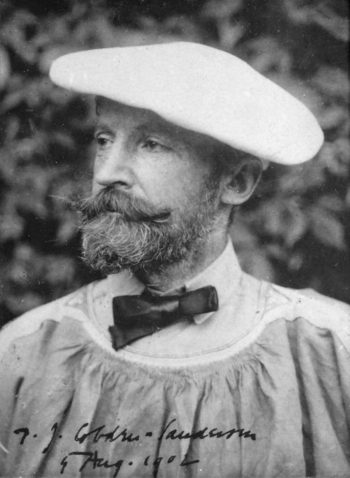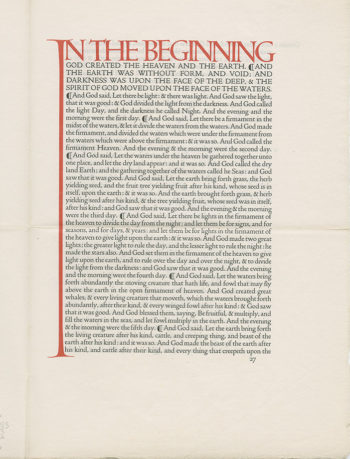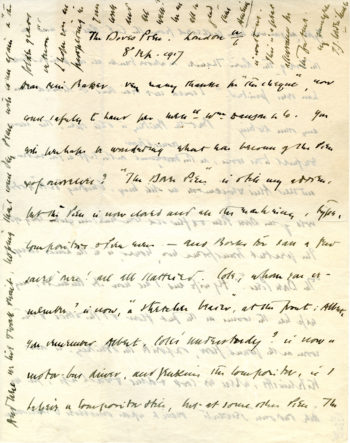
Cobden-Sanderson and the Doves Press

In the early 1880s, Thomas James Cobden-Sanderson left a career in law to become a bookbinder. Cobden-Sanderson was a friend of William Morris, a prominent member of the British Arts and Crafts movement, and subscribed to his ideology about the importance of traditional craftsmanship. They believed that the artistry of bookmaking was being destroyed by mass-production, and they sought to produce high-quality books crafted with an attention to design and detail. Roughly ten years after first leaving his career in law, Cobden-Sanderson founded the Doves Bindery with the financial support of his wife, Anne Cobden-Sanderson, a famous suffragette from a wealthy family.
Bringing the Art of Bookbinding to America
Cobden- Sanderson was known as a leader in the English Arts and Crafts Movement and took on a succession of talented female pupils with whom he and his wife formed close friendships. These American women, including Washington University alum Cordelia Baker, fervently shared his ideals on bookmaking with a new audience back in the United States, where they made his name well-known.
In 1907, shortly before Cobden-Sanderson would take on his last American pupil, he made a lecture tour in the U.S., staying with a number of his former students. His wife came with him, and her imprisonment for her involvement with the suffragettes the year before caused some difficulty in their travel arrangements. Instead of sailing directly to the U.S. and risking trouble with immigration, the couple chose to sail to Canada and cross the border into Chicago, where they were less likely to be refused entry. Anne Cobden-Sanderson gave at least one talk on women’s rights while she was in the states, and T.J. worked his own ideas about suffrage into his lectures.
From Bindery to Press
In its early days, the Doves served as the main bindery for William Morris’ Kelmscott Press. In 1899, after the Kelmscott Press closed, Cobden-Sanderson opened his own press, known as the Doves Press. The Kelmscott and Doves presses, together with another English press known as Ashendene Press, make up what is now known collectively as the Triple Crown Presses, which sought to resist the dehumanization and mass production of the Industrial Revolution through reviving the high art of bookmaking.

Throwing the Type into the Thames
Shortly after starting his press, Cobden-Sanderson invited Emery Walker to be his partner, and together they commissioned the creation of a type to be used in all Doves publications. The partnership only lasted until 1908, however, when it was dissolved by a dispute. Cobden-Sanderson continued to print, but according to their dissolution agreement, the type was to go to Walker after Sanderson’s death. Rather than have this happen, Cobden-Sanderson threw the type into the River Thames.

Below is the last known letter that Cobden-Sanderson sent to Cordelia Baker in which he tells her that he has thrown the type into the river. Written in 1917 as WWI was ravaging Europe, it also describes how the Doves Press, where Cobden-Sanderson still resides with his wife, has closed down its machinery, while the bindery is occupied with binding odd volumes and old commissions. The bindery would remain open until 1921, roughly a year before Cobden-Sanderson’s death. After his death, Walker discovered what he had done to the type and sued Anne Cobden-Sanderson for £700.
Drudging up the River Thames

Nearly a century after the type was lost, a designer named John Green embarked on a years-long project of trying to recreate the type digitally. As a culmination of this project, he decided to see if he could find any of the original type and scoured Colbden-Sanderson’s journals to try to map out exactly where he had tossed it. In early 2015, Green had a team of professional divers from the Port of London Authority spend two days searching the River Thames, and was able to recover 150 pieces. Green has donated half of the type to the Emery Walker Trust, honoring the agreement that Cobden-Sanderson so dramatically broke a hundred years before.
More about the Doves
Washington University Libraries has a variety of materials on Cobden-Sanderson, including his correspondence with Cordelia Baker, a book of his lectures when he was in the United States, and almost the complete output of the Doves Press. For more information on the Triple Crown Presses, including the Doves, please see our previous blog post and check out the Triple Crown finding aid.
Sources
- Beal, Tom. “One Man’s Obsession with Uncovering a Lost Typeface.” BBC.com. 20 Feb. 2015.
- Dryfus, John. “Introduction.” Four Essays by T.J. Cobden-Sanderson, San Francisco: Book Club of California, 1974.
